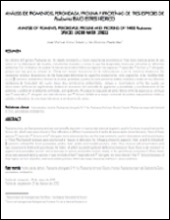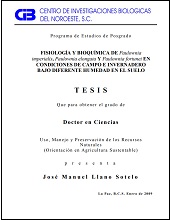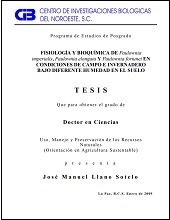ANÁLISIS DE PIGMENTOS, PEROXIDASA, PROLINA Y PROTEÍNAS DE TRES ESPECIES DE Paulownia BAJO ESTRES HÍDRICO
ANALYSIS OF PIGMENTS, PEROXIDASE, PROLINE AND PROTEINS OF THREE Paulownia SPECIES UNDER WATER STRESS
| dc.creator | José Manuel Llano Sotelo | |
| dc.creator | LILIA ALCARAZ MELENDEZ | |
| dc.date | 2012 | |
| dc.identifier | http://cibnor.repositorioinstitucional.mx/jspui/handle/1001/858 | |
| dc.identifier | https://cibnor.repositorioinstitucional.mx/jspui/handle/1001/858 | |
| dc.identifier.uri | http://dspace.cibnor.mx:8080/handle/123456789/1648 | |
| dc.description | "Los árboles del género Paulownia son de rápido crecimiento y tienen importancia económica en Asia como materia prima de uso común en la elaboración de muebles, instrumentos musicales y cercos, lo que ha despertado interés por cultivarlos en diferentes ambientes. Con el objetivo de evaluar la tolerancia al estrés hídrico se eligieron tres especies, P. imperialis, P. fortunei y P. elongata, porque son las que se utilizan en China con mayor frecuencia en la reforestación y en la industria maderera. Se realizaron análisis bioquímicos de las hojas para determinar los siguientes componentes: como pigmentos, a las clorofilas total, a y b; β-caroteno, violaxantina y luteína); las enzimas peroxidasa y prolina, así como proteínas solubles, insolubles y totales en tres diferentes condiciones de humedad del suelo, bajo dos condiciones ambientales, campo e invernadero, entre los cuales se observaron diferencias significativas; destaca un incremento del contenido de pigmentos y peroxidasa, y una disminución de las proteínas y prolina en el ambiente controlado, principalmente. Al evaluar la respuesta al estrés hídrico entre las especies se concluyó que P. imperialis y P. elongata son más tolerantes que P. fortunei, debido a su mayor contenido de prolina, mas proteínas totales y solubles, indicadores de una mejor tolerancia a condiciones de estrés." | |
| dc.description | "Paulownia trees are fast growing and are economically important in Asia as raw material regularly used for furniture, musical instruments, fences, etc., which rose some interest in their cultivation in different environments. In order to assess water stress tolerance, three of these species, P. imperialis, P. fortunei and P. elongate, were selected as they are the most commonly used in reforestation and wood industry in China. Biochemical analyses were performed in leaves, to determine the following elements: pigments (total, a and b chlorophyll; β-carotene, violaxanthin; lutein), peroxidase, proline, total, soluble and insoluble proteins, under three moisture soil concentrations and two environments, field and greenhouse, the latter of which revealed significant differences between them; there is an increment in pigment and peroxidase content and a decrease in protein and proline content, mainly in the greenhouse environment. When water stress was assessed among species, it was concluded that P. imperialis and P. elongata are more tolerant than P. fortunei because of their higher content of proline, total and soluble proteins, which are major tolerance markers in stress conditions. " | |
| dc.format | application/pdf | |
| dc.language | spa | |
| dc.publisher | Instituto Nacional de Investigaciones Forestales, Agrícolas y Pecuarias | |
| dc.relation | info:eu-repo/semantics/reference/ISSN/ISSN: 2007-1132 | |
| dc.relation | info:eu-repo/semantics/reference/URL/URL: http://cienciasforestales.inifap.gob.mx/ | |
| dc.relation | citation:Llano Sotelo, José Manuel, & Alcaraz Meléndez, Lilia. (2012). Análisis de pigmentos, peroxidasa, prolina y proteínas de tres especies de Paulownia bajo estres hídrico. Revista mexicana de ciencias forestales, 3(9), 69-80. | |
| dc.rights | info:eu-repo/semantics/openAccess | |
| dc.rights | http://creativecommons.org/licenses/by-nc-nd/4.0 | |
| dc.source | Revista Mexicana de Ciencias Forestales | |
| dc.subject | info:eu-repo/classification/AUTOR/Aminoácidos, luteína, Paulownia elongata S. Y. Hu, Paulownia fortunei (Seem.) Hemsl., Paulownia imperialis Siebold & Zucc., peroxidasa, violaxantina | |
| dc.subject | info:eu-repo/classification/AUTOR/Amino acids | |
| dc.subject | info:eu-repo/classification/cti/2 | |
| dc.subject | info:eu-repo/classification/cti/24 | |
| dc.subject | info:eu-repo/classification/cti/2417 | |
| dc.subject | info:eu-repo/classification/cti/241719 | |
| dc.title | ANÁLISIS DE PIGMENTOS, PEROXIDASA, PROLINA Y PROTEÍNAS DE TRES ESPECIES DE Paulownia BAJO ESTRES HÍDRICO | |
| dc.title | ANALYSIS OF PIGMENTS, PEROXIDASE, PROLINE AND PROTEINS OF THREE Paulownia SPECIES UNDER WATER STRESS | |
| dc.type | info:eu-repo/semantics/article | |
| dc.type | info:eu-repo/semantics/publishedVersion |




